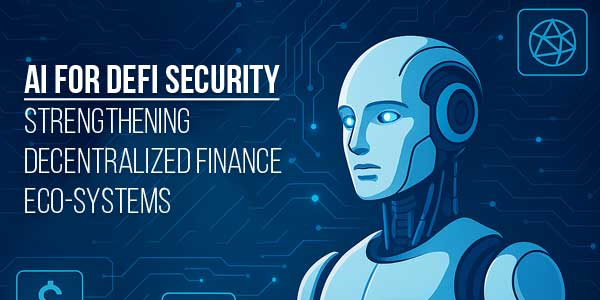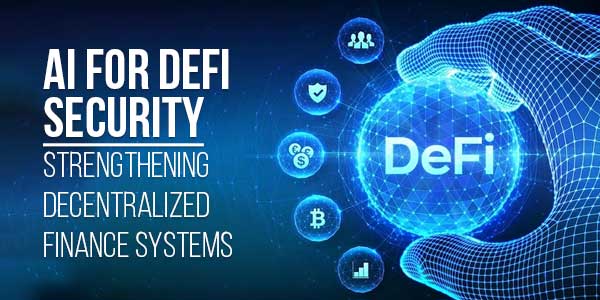
Decentralised Finance (DeFi) has turned the financial industry on its head. In just a few years, billions of dollars have flowed into DeFi protocols, giving people worldwide access to lending, trading, and investing without traditional banks. Yet with great opportunity comes great risk. Hacks, scams, and smart contract exploits continue to haunt DeFi.
This is where AI for DeFi Security steps in. Artificial Intelligence offers new ways to monitor, predict, and respond to threats across decentralised ecosystems. For CTOs, tech leaders, and decision-makers in fintech, understanding how AI strengthens DeFi security is no longer optional—it’s mission-critical.
Table of Contents
The Rising Risks In DeFi:
DeFi is fast, borderless, and often experimental. That speed of innovation creates vulnerabilities. A 2023 report from Chainalysis found that over $3.8 billion was stolen in crypto hacks—a record high, with most attacks targeting DeFi protocols. Many of these incidents came down to smart contract bugs, phishing, or flash loan exploits.
Unlike traditional finance, DeFi has no central authority to freeze suspicious transactions. Once assets move, recovery is rare. For technology leaders, the challenge is finding ways to prevent these losses before they happen.
In 2022, attackers stole a record $3.8B, and DeFi protocols accounted for 82.1% of all stolen value, with cross-chain bridges bearing most of the damage, per the Chainalysis 2022 hacking analysis.
Why AI Is a Game-Changer for DeFi Security?
Artificial Intelligence thrives where data is abundant and patterns matter. DeFi, running on transparent blockchains, generates massive amounts of real-time data—transactions, wallet behaviours, and liquidity flows. AI tools can learn from this information to spot suspicious activity faster than any human team.
Some of the ways AI for DeFi Security is transforming the space include:
- Anomaly Detection: AI can flag unusual wallet movements or sudden liquidity changes that may signal an exploit.
- Predictive Analysis: By studying historical hacks and fraud attempts, AI models can anticipate where new vulnerabilities might appear.
- Automated Response: AI-powered bots can take quick defensive actions, such as pausing contracts or alerting stakeholders, before major damage occurs.
When paired with human oversight, these tools provide an extra layer of defence in a high-risk environment.
The Human + AI Partnership:
It’s tempting to think AI will solve every security problem in DeFi. The truth is more balanced. AI is powerful at identifying patterns and anomalies, but human experts still bring context, strategy, and judgment.
For example, if AI spots a sudden $10 million movement in liquidity, it could be a legitimate whale transaction or a sign of an exploit. Security teams need to interpret the data and decide on the right response.
This is why many DeFi projects are turning to a custom AI development company like Hidden Brains to build solutions that combine automation with human oversight. By integrating AI into existing workflows, teams can act faster without losing control of critical decisions.
For DeFi projects, blending automation with human expertise is key. Even in content workflows, AI plays a similar role—tools like free AI content checker tools for blogs help writers validate originality while editors bring context and nuance. The same balance applies in financial security.
Real-World Uses of AI in DeFi:
Let’s break down a few practical applications already shaping the landscape:
- Fraud Detection in Real Time: AI models trained on millions of wallet addresses can flag suspicious behaviour instantly. This is similar to how credit card companies detect unusual spending, but applied on a blockchain scale.
- Smart Contract Auditing: Bugs in smart contracts account for a large share of DeFi losses. AI-powered tools can scan and analyse contract code faster than manual audits, reducing the chance of overlooked vulnerabilities.
- Market Manipulation Monitoring: Wash trading and pump-and-dump schemes distort markets. AI can track trading activity across exchanges, highlighting irregular patterns that may harm users.
- AI-Driven Chatbots for Support: DeFi platforms often struggle with user trust after security scares. Intelligent chatbots can guide users, answer questions, and provide instant support during incidents. Companies can Hire Dedicated Chatbot Developers to make customer interactions smoother and safer.
Fact Check: AI Adoption Is Rising
To put this into perspective:
- According to Gartner, by 2026, 60% of organisations will use AI for cybersecurity, up from less than 10% in 2022.
- A PwC study found that AI could cut financial fraud losses by up to 40% when combined with real-time monitoring systems.
These statistics highlight why decision-makers in fintech cannot afford to ignore AI’s growing role in securing DeFi platforms.
Integrating AI into Fintech Strategies
For leaders in the U.S. fintech space, the big question is not if AI should be part of a security strategy, but how. Integration requires careful planning:
- Define the Scope: Identify which parts of your DeFi ecosystem are most at risk—smart contracts, liquidity pools, or user wallets.
- Choose the Right Partners: Working with a trusted fintech software development company helps align AI tools with business needs.
- Balance Automation and Control: Allow AI to monitor and alert, but keep human teams in charge of final responses.
- Continuous Training: AI models improve with fresh data. Constant updates help them stay effective against new attack methods.
For CTOs, AI in DeFi security isn’t just about technology—it’s about protecting reputation, investor trust, and long-term growth.
Choosing partners and building strategies isn’t just about technology—it’s about aligning with broader goals. Just as businesses weigh the pros and cons of AI SEO and traditional SEO, fintech leaders must evaluate how AI complements, rather than replaces, existing security approaches.
The Road Ahead:
DeFi is still in its early stages, and so is the use of AI to secure it. But one thing is clear: attackers are getting smarter, and defenders need to move faster. AI’s ability to learn, adapt, and act in real-time offers the best chance of staying ahead.
Think of it this way: DeFi without AI security is like driving a race car without brakes. The potential is huge, but the risks are equally high. Adding AI gives projects the control and safety they need to thrive in the long run.
Case Studies: AI Making a Difference in DeFi
Several projects have already begun integrating AI for DeFi Security with promising results. While many solutions are still in early adoption, real-world examples demonstrate the power of this approach.
- AI-Powered Smart Contract Audits: Some DeFi auditing firms now deploy AI tools that scan millions of lines of code in minutes. Instead of relying only on manual checks, these systems identify vulnerabilities such as reentrancy attacks, integer overflows, and logic flaws. The result? Faster, more comprehensive audits and fewer high-profile exploits.
- AI-Enhanced Risk Scoring for Wallets: Platforms are experimenting with AI-driven scoring systems to classify wallets by behaviour. For instance, a newly created wallet interacting with dozens of contracts in seconds might raise a red flag. This information allows DeFi protocols to block or limit suspicious wallets before damage occurs.
- Fraud Prevention in Lending Platforms: DeFi lending platforms are particularly vulnerable to flash loan attacks. AI models trained on historical lending data can flag manipulative attempts before loans are issued, saving millions in potential losses.
These examples underscore how AI tools, when integrated thoughtfully, can reduce risks and boost trust in decentralised ecosystems.

Future Trends: What’s Next for AI in DeFi Security
The marriage of AI and blockchain is still evolving. Looking ahead, several trends are worth watching:
- Decentralised AI Networks: Instead of centralised AI tools, decentralised AI models may run on blockchain, bringing transparency and reducing reliance on single points of failure.
- On-Chain AI Agents: Autonomous AI agents could interact directly with smart contracts to pause activity, rebalance liquidity, or trigger emergency protocols without human intervention.
- Federated Learning for DeFi: Projects may share anonymised security data across networks to train stronger AI models without compromising user privacy.
- AI-Powered Insurance Models: Insurance providers in DeFi could use AI to predict risks, price coverage more accurately, and pay out claims automatically.
These innovations will further shape how DeFi grows while keeping security at the forefront.
Beyond finance, AI is reshaping industries from healthcare to media. For instance, AI-powered social trends already help businesses predict customer behaviour—showing how predictive analytics in DeFi security could evolve in similar ways.
Challenges: Why AI Alone Isn’t Enough
For all its potential, AI is not a silver bullet. CTOs and fintech leaders must approach integration with realistic expectations.
- False Positives: AI might flag legitimate transactions as threats, frustrating users and slowing down operations.
- Data Privacy: Training AI on blockchain data is straightforward, but combining it with off-chain data raises questions about compliance and user privacy.
- Adversarial Attacks: Hackers can try to trick AI models by mimicking normal behaviour. As AI defences grow, attackers adapt too.
- Costs and Expertise: Building effective AI models requires significant investment and the right development partners. Without expertise, solutions may fall short.
These challenges highlight why combining AI tools with strong governance and expert human teams remains essential.
According to CertiK’s 2023 review, private key compromises were the costliest vector, driving about $880.9M in losses across 47 incidents—a reminder to pair AI monitoring with strong key management.
Transparency is another concern. Just as platforms are now exposing hidden AI features on social media, DeFi projects must remain open about how AI models operate to maintain user trust.
Regulatory Perspectives on AI and DeFi:
DeFi operates in a regulatory grey area, especially in the U.S., where agencies are still defining their stance. When adding AI into the mix, compliance becomes even more complex.
For instance, regulators may require DeFi platforms to explain how AI models make decisions. Transparency is key, particularly when blocking transactions or scoring wallets. The European Union’s upcoming AI Act sets clear rules on explainability, which may influence future U.S. policies.
Tech leaders should stay ahead of these developments. Embedding explainability into AI systems today avoids headaches tomorrow. It also builds trust with users and regulators alike.
Actionable Steps for CTOs and Decision-Makers:
For leaders in fintech and DeFi, here’s a practical roadmap to start leveraging AI for DeFi Security:
- Audit Current Risks: Map out where your protocol or platform is most exposed—smart contracts, user wallets, or third-party integrations.
- Start with Monitoring: Begin with AI-driven monitoring tools that detect anomalies. This offers quick wins without overhauling the system.
- Invest in Development Partners: Collaborate with a trusted custom AI development company that understands fintech challenges. Building in-house may be costly; experienced partners reduce risks.
- Combine User Education with AI: Technology is powerful, but users are often the weakest link. Pair AI tools with education, guided by intelligent bots built through Hire Dedicated Chatbot Developers. This helps users spot phishing attempts and avoid scams.
- Iterate and Improve: AI models evolve with new data. Regularly retrain them to adapt to fresh attack methods. Don’t treat AI as a one-time fix.
- Align with Industry Leaders: Work with an experienced fintech software development company that can integrate AI security with broader financial solutions. The right alignment helps scale AI defences as your platform grows.
When improving user support, leaders can also look to the best practices in digital communication. Studying examples like the best AI chatbots for content writing highlights how conversational AI can be adapted for security education and customer guidance in DeFi.
Why Now Is the Time?
The DeFi ecosystem continues to expand at breakneck speed. Billions in total value locked (TVL) and millions of users rely on platforms every day. With hackers growing more sophisticated, waiting to adopt AI solutions leaves projects dangerously exposed.
Consider this: in 2022, DeFi accounted for 82% of all stolen cryptocurrency worldwide, according to Chainalysis. Numbers like these highlight the urgent need for innovation. AI offers a path forward—providing security that scales with growth.
Chainalysis’ latest data shows $2.2B was stolen in 2024, and incidents rose to 303, underscoring why AI for DeFi Security needs to be proactive, not reactive.
A CTO’s Perspective:
Imagine being a CTO watching your platform gain traction. Liquidity is flowing in, partnerships are forming, and users are growing. Then one morning, you wake up to a drained protocol because of a flaw missed in manual audits.
This nightmare has already played out for many DeFi projects. The reputational damage is often worse than financial loss. Investors and users rarely return after a major breach.
Integrating AI into your security stack is like hiring a team of digital sentinels—always awake, always learning, always watching. It won’t eliminate every threat, but it significantly reduces the odds of catastrophic failure.
Final Thoughts: Building Trust in DeFi with AI
DeFi’s promise is freedom—open access to financial tools without intermediaries. But freedom comes with responsibility. Without strong security, trust erodes, and innovation stalls.
AI for DeFi Security is more than a trend. It’s a foundation for building safe, resilient, and trustworthy ecosystems. For U.S. tech leaders, the choice is clear: embrace AI now, or risk being left behind in a rapidly evolving industry.
Artificial Intelligence won’t replace human judgment, but it will empower teams to act faster, smarter, and with more confidence. By partnering with experts, adopting proven tools, and staying agile, fintech leaders can safeguard their platforms and build a brighter future for decentralised finance.

 About the Author:
About the Author:
















Be the first to write a comment.